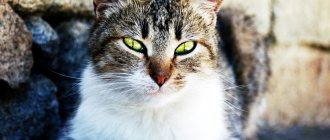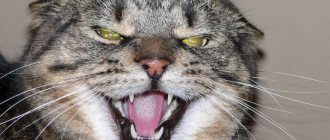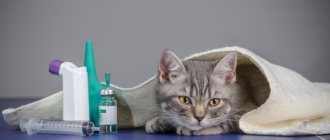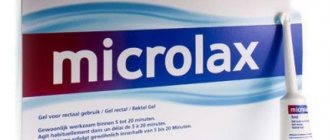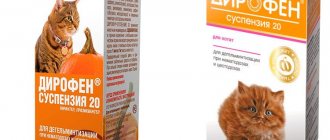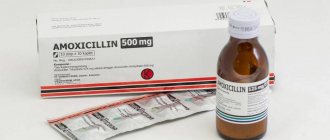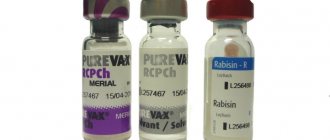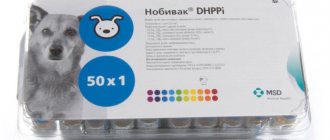Instructions
You can give ketosteril to your fluffy in different ways, then we will tell you about them in detail.
1 option
- Wrap your pet in a towel, it is important to leave only the muzzle free.
- Wear disposable rubber gloves and remove the tablet from the blister.
- Place the cat on your lap, it is important that the cat's head is located above body level.
- Open the cat's mouth with one hand, and with the other hand place the tablet on the base of the tongue. This way you will provoke a swallowing reflex, and therefore the cat will swallow the tablet.
Option 2
- Remove from packaging.
- Put on sterile seals.
- Grind into powder with a knife or spoon.
- Take a syringe without a needle and remove the plunger from it.
- Pour the tablet powder into the syringe body.
- Carefully insert the plunger, turn the syringe nozzles up and slowly release the air from the cylinder.
- Draw 3-4 ml of warm water inside.
- Cover the spout with your finger and shake it well. This must be done until the tablet powder is completely dissolved.
- Ask someone close to you to hold your pet.
- Open your mouth, and then release the medicine in a stream onto the roof of your mouth. It is important to hit the palate; in this case, the suspension prepared from the ketosteryl tablet will definitely fall into the esophagus.
It is strictly forbidden to mix Ketosteril with any food, as the components may interact. Therefore, it is not the medicinal product that may enter your pet’s body, but a dangerous chemical compound.
diabetes
Price and analogues
The cost of the drug differs slightly depending on the manufacturer:
- tablets Fresenius Kabi Deutschland (Germany) No. 100 – 2525 rubles;
- tablets Beiging Fresenius Kabi Pharmaceutical (China) No. 100 – 2480 rub.
Other products and analogues have similar properties:
- Vita-iodurol;
- Dibikor;
- Histidine hydrochloride;
- Vicein;
- Taufon.
Ketosteril should be used only as prescribed by a veterinarian.
If side effects occur, you should immediately stop taking the medication and inform a specialist to make adjustments to the treatment plan.
Dosage
Consult a specialist.
After all, the doctor calculates the dosage depending on the cat’s health condition. In case of renal failure, the optimal dosage is calculated according to the following scheme: 1 tablet of the drug per 5 kg of cat’s body weight. It is given once a day, the course of treatment depends on the degree of renal failure, as well as other factors. Dose selection
| Mass of the cat | Dose of Kestostiril, day |
| 2.5 kg | 0.5 tablets |
| 5 kg | 1 tablet |
| 7.5 kg | 1.5 tablets |
| 10 kg | 2 tablets |
Some owners decide on their own how to give ketosteril to their pet. Some people simply break a tablet and give it morning and evening. But this is a gross violation of the manufacturer’s recommendations for taking the medicine. The fact is that the tablet has a protective shell that protects the pet’s esophagus and stomach from harmful effects. And thus it is delivered directly to the small intestine, where it will be gradually absorbed into the blood. If you break it, its protective shell is broken. This will not only affect the effectiveness of the treatment, but can also negatively affect the cat's condition.
Composition of the drug
Ketosteril is a medical drug that is used in human and veterinary medicine for renal failure and other chronic kidney diseases. The main cause of such diseases is a lack of amino acids in the animal’s body. That is why ketosteril is an amino acid complex containing the following basic substances:
- lysine acetate;
- nitrogen;
- threonine;
- phenylpropionic acid;
- calcium salt.
The excipients of the drug include components that promote the most rapid absorption of the drug into the blood and tissues.
How it works
Ketosteril's task is to restore the normal level of amino acids, which are produced by the body in small quantities. During the natural transfer of amino acids, ammonia is produced, and its presence in the body has a detrimental effect on the kidneys. Thus, amino acids enter the body with ketosteril, and an excess of ammonia does not occur in the cat’s body.
Examination
Taking ketosteril allows you to:
- remove nitrogen-containing compounds, thus improving mineral-protein metabolism;
- remove toxic compounds released due to kidney problems;
- reduce the amount of phosphates, potassium and magnesium;
- maintain stable functioning of the immune system;
- partially break down lactic acid in the blood of baleen;
- stop the exhaustion of the body.
Causes of kidney failure and its types
Renal failure is a pathological condition in which the kidneys perform their excretory function poorly or stop performing it altogether. Due to disturbances in the functioning of the excretory system, the balances in the body are disturbed: acid-base, water-salt and osmotic. It is these disorders that eventually lead to problems in the condition of other internal organs.
- acute (API);
- chronic (CRF).
The disease is considered completely incurable, and in some cases can lead to the death of the cat. But timely prescribed therapy allows you to slow down its development and progression, prolonging the relatively normal life of your pet.
The most important reason for the development of renal failure is diseases accompanied by direct damage to the kidneys. Once clinical signs appear, it is almost impossible to identify the exact cause of its appearance. Any additional studies after making a clinical diagnosis reveal damage or degeneration of renal tissue, which is characteristic of almost all existing kidney pathologies.
- frequent inflammation of the kidneys, as well as improper or incomplete healing;
- toxic or mechanical damage to the kidneys;
- glomerulonephritis (damage to the zona glomerulosa);
- congenital pathologies;
- infectious diseases and bacterial lesions (pyelonephritis);
- tumor processes (both benign and malignant) that impair the excretory function of the kidneys;
- renal polycystic disease (a genetic disease common to many exotic cat breeds, accompanied by the formation of cavities in the kidneys filled with fluid);
- autoimmune glomerulonephritis (genetic predisposition);
- unilateral hypoplasia (when one kidney significantly lags behind the other in development, and in old age the organ affected by the pathology simply fails - occurs only in cats).
Contraindications and side effects
The use of the drug is contraindicated in pets that:
- have not reached a weight of 1 kg;
- suffer from phenylketonuria;
- do not tolerate ketosteril components;
- take a drug containing calcium, and they, accordingly, have an increased level of calcium in the blood.
If you follow the dosage prescribed by the veterinarian, there is no negative effect on the pet’s health. But if it is exceeded, an overdose of calcium may occur, and this has a bad effect on the pet’s condition. Then the following symptoms appear:
- lethargy;
- rapid breathing;
- limb spasms;
- loss of interest in food;
- aggressiveness;
- nausea;
- vomit;
- lack of coordination.
Analogues and prices
The drug "Ketosteril" is quite expensive. Its cost is 3000 rubles. Since a whole package of medicine is not needed to treat one cat, animal owners are trying to unite and purchase it for several pets. There are no complete analogues of Ketosteril, but there are several medicines whose effects are very similar.
These include:
- "Gepasol-Neo" is a drug in the form of a solution that normalizes metabolism and prevents liver diseases.
- “Ketoaminol” is a tablet product that replenishes amino acid deficiency and restores metabolism.
- "Nephrotect" is a solution that contains essential and essential amino acids and helps produce protein.
"Ketosteril" enjoys a good reputation among cat owners and veterinarians during the treatment of chronic renal failure or other kidney diseases associated with metabolic disorders.
If you follow all the recommendations of your veterinarian, this medicine will help your pet quickly recover and improve its well-being.
Breeders reviews
Olga: We noticed kidney failure in Mila the cat at an early stage. As an auxiliary therapy, the veterinarian prescribed Ketosteril tablets. Apparently, after 2-3 weeks, the urea and creatine levels were restored, and the cat began to feel much better. She even stopped making sounds when going to the toilet. The product is effective, and this is quite logical, because I paid about 3,000 rubles for it. There were no side effects, so I can recommend it!
Ilya: My cat was diagnosed with pyelonephritis, and the doctor prescribed Ketosteril for treatment. The medicine is effective, the doctor noted that my Mashenka is recovering. Now her health is good, the veterinarian recommended that she be monitored every 2 months. In this case, it will be possible to notice complications and begin treatment in a timely manner. The only thing I didn’t like was its cost, since it exceeds 2,500 thousand. But here, as they say, you don’t have to choose, because the health of your beloved pet is much more valuable than any money!
When is Ketosteril prescribed?
Despite the fact that the box contains instructions for using Ketosteril, only a veterinarian should prescribe the exact dosage for cats and dogs. The most common disease for which this medicine is prescribed is chronic renal failure.
This problem is very common in cats, but in the early stages, it is almost impossible to recognize the disease on your own. The animal's behavior and activity remain the same and do not cause suspicion. For this reason, it is worth visiting a veterinary clinic for examination at least once every 6 months.
The first warning sign that alarms owners is the cat’s increased thirst. With rapidly developing renal failure in cats, a process of dehydration occurs. The pet is thirsty in the absence of extreme heat and food that causes natural thirst. At the same time, the urge to urinate is not frequent, and there is much more urine. Against this background, the cat may experience:
- Poor appetite;
- Attacks of vomiting;
- Lethargy and depression.
If your pet has indications for the use of Ketosteril for a cat, but the cost of the drug is not suitable, the veterinarian may suggest that you team up with the owners of an animal with a similar diagnosis when purchasing. It is quite profitable to buy a package of Ketosteril and cure your cat without extra costs.
shutterstock
Ketosteril is also used for prolonged unpleasant odor from the mouth, deterioration of coat quality, dry skin, and small mouth ulcers in cats. These symptoms can be either signs of kidney failure or signal another disease.
Another disease for which Ketosteril can help is urolithiasis. If an animal has dysfunctions of the genitourinary system, the drug will help improve the general condition of the body, as well as restore it after surgery, if necessary.
Reviews from veterinarians
Alena: Many veterinarians praise the drug, but I’m not one of them. After all, I understand perfectly well that there is no remedy that would improve kidney function. Nevertheless, this is exactly how manufacturers praise ketosteril. It does an excellent job of getting rid of toxins, you can’t argue with that. But I wouldn’t pay more than 3 thousand for such a product!
Valentin: Ketosteril is a wonderful adjunct in the treatment of renal failure. This drug cannot replace the main treatment, but it can enhance the effect. In the last stages of the disease, it is not possible to cure your pet. In this case, most likely he will switch to maintaining life with ketosteril. If you decide to use the drug to treat your furry, then pay attention to side effects, as they may occur. Then you need to immediately stop the therapy and go to a veterinary clinic for consultation.
Complete instructions for use of the drug ketosteril for cats
Kidney failure is a serious disease that causes not only severe symptoms, but also kidney dysfunction. Therapeutic therapy for cats includes powerful drugs with a restorative effect. I will talk about the features of one of them in the article. I will give a detailed description of the properties of ketosteryl, rules of use and storage.
The drug is developed on the basis of several active ingredients and other substances that promote better absorption of the drug by the body.
Ketosteril for cats is considered one of the best drugs that fight kidney failure well
The complex product includes:
- DL-methyl-oxo-2-calcium valerinate;
- Oxo-2-phenyl-3-calcium propionate;
- Methyl 4-oxo-2-calcium valerinate;
- Methyl oxo-2-calcium butyrate;
- DL-hydroxy-2-calcium methylbutyrate;
- L-histidine;
- L-threonine;
- L-lysine monoacetate;
- L-tyrosine.
And also: colloidal silicon dioxide, corn starch, talc, polyvinylpyrrolidone, polyethylene glycol 6000, magnesium stearate.
Brief description of the tablets:
- shape – oblong;
- yellow color;
- the presence of a protective shell that prevents irritation of the mucous membrane during passage into the stomach through the esophagus.
Ketosteril is recommended by experts for use in the following cases:
- with protein-energy deficiency;
- to eliminate problems associated with metabolic disorders;
- for preventive purposes;
- with urolithiasis;
- for the treatment of renal failure (including the chronic form of the disease).
Only a veterinarian can prescribe the drug to a pet after an examination. Early detection of renal failure is complicated by the lack of obvious signs that breeders can notice.
The specialist has all the necessary tools and equipment, which helps to identify the problem at an early stage of development. Therefore, it is recommended to visit the clinic every six months for a preventive examination.
Cats should be treated with the drug strictly after consultation with a veterinarian.
The principle of operation of the product is based on replenishing the body with essential amino acids, while a minimal amount of nitrogen is used to transport microelements. Active components promote the utilization of nitrogen-containing metabolic products, while simultaneously regulating nitrogen and protein metabolism. Taking the drug leads to a decrease in the content of phosphorus, potassium and magnesium ions in the blood.
The duration of treatment depends on the degree of complexity of the disease. The dosage regimen is developed exclusively by a veterinarian.
This dosage is suggested for the treatment of acute forms of the disease or chronic renal failure. If the drug is prescribed for prophylactic purposes or as an additional component in complex therapy, the dose is reduced to 1/8 or 1/4 of a tablet taken twice a day.
Rules for taking ketosteril:
- separate the desired part of the tablet or take the whole one;
- grind it to a powder;
- dilute in a cup with a small amount of purified water (up to 10 ml);
- draw the resulting solution into a syringe (without a needle!);
- inject into the cat, placing the base of the syringe in the side of the jaw, where the small teeth are located.
Do not mix the tablet with your favorite treat or food.
Contact with products may result in the formation of chemical compounds that reduce the effectiveness of treatment or pose a danger to the body.
For cats bearing offspring and nursing kittens, the use of the drug is strictly prohibited. At this stage, the animal and babies may develop various health problems, which will require more serious treatment.
The developers identify the following restrictions on taking the medicine:
- hypercalcemia;
- presence of amino acid metabolism disorders;
- individual intolerance to the constituent substances.
Contraindications are also periods of pregnancy and lactation.
The drug cannot be combined with vitamin D or tetracycline antibiotics.
Side effects may occur when taking the drug. This mainly concerns increasing calcium levels in the body and allergies.
Before use, be sure to read the instructions
The following signs indicate a side effect:
- rapid and difficult breathing;
- decreased appetite;
- convulsions;
- change in pet behavior (irritability);
- increase in body temperature.
The drug retains its properties for 3 years after release from production under the following conditions:
- ambient temperature – 0-25°C;
- humidity – within 40-60%;
- lack of sunlight.
Price and analogues
The cost of the drug differs slightly depending on the manufacturer:
- tablets Fresenius Kabi Deutschland (Germany) No. 100 – 2525 rubles;
- tablets Beiging Fresenius Kabi Pharmaceutical (China) No. 100 – 2480 rub.
Other products and analogues have similar properties:
- Vita-iodurol;
- Dibikor;
- Histidine hydrochloride;
- Vicein;
- Taufon.
Ketosteril should be used only as prescribed by a veterinarian.
If side effects occur, you should immediately stop taking the medication and inform a specialist to make adjustments to the treatment plan.
Ketosteril for cats is considered today one of the best drugs that fight kidney failure well. This disease not only causes unpleasant and very severe symptoms, but also gradually leads to complete kidney dysfunction.
Ketosteril, as practice shows, can be used both for treating people and for treating animals. But for the treatment to be truly effective, you need to find out as much information as possible about this drug. Let's get acquainted with it now.
The drug Ketosteril, the instructions for use of which are indicated on the packaging, contains several active ingredients.
The medicine contains lysine acetate, nitrogen, threonine, phenylpropionic acid and calcium salt in sufficient quantities.
There are also auxiliary components that promote better absorption of the drug into the blood and tissues.
The main function of Ketosteril is to supply the cat’s body with all the necessary amino acids. As practice shows, when they are deficient, kidney failure most often gradually develops.
Ketosteril is produced in the form of tablets, which are coated with a protective coating. Under the action of enzymes in the cat's stomach, this membrane is destroyed, and all active components are released. It is at this time that the medicine begins to work.
But along with the main indications, there are also some contraindications and precautions when using this drug.
If this is not taken into account, then the use of Ketosteril can lead to a deterioration in the animal’s well-being and negative dynamics of the disease.
If the drug is used in incorrect dosages, hypercalcemia may occur in the animal after some time. This is especially dangerous for kittens whose skeletons have not yet developed enough.
Some cats, especially purebred ones, have increased sensitivity to certain components of Ketosteril. It is almost impossible to detect this immediately, and for this reason it is necessary to first limit yourself to a very small amount of the drug.
An allergic reaction usually manifests itself in an increase in the animal’s body temperature and in a more pronounced expression of the symptoms of the disease. If this is noticed, you should immediately stop giving the cat this medicine, inform your veterinarian and find a suitable analogue.
But there are also direct contraindications for the use of Ketosteril for cats. If an animal already has excess calcium in its body, then using this medicine is not recommended. Also, you should not give tablets to cats whose amino acid metabolism in the body is severely impaired.
And under no circumstances should you give a dose of this drug simultaneously with other tetracycline drugs or medications containing large amounts of vitamin D. Consumption of calcium and vitamin D separately should also be limited for a while.
But it is also important to know how to properly treat cats with Ketosteril. After all, the use of this drug in veterinary medicine and conventional medicine for humans is somewhat different. In animals, the excretory system has its own characteristic features.
Most often, the dosage for an animal is completely the same as the dosage for small children. Many veterinarians prescribe giving the drug to cats at the rate of 1 whole tablet per 5 kg of animal weight. In this case, the medicine is given once a day. But the course of treatment is prescribed only by an experienced veterinarian.
Some owners prefer to divide the tablet into several parts, which are then supposed to be given to the animal daily.
After all, when dividing the tablet, a partial violation of the integrity of the shell occurs, which is why the medicine may lose some of its beneficial properties.
Caring owners should still know a few basic subtleties about treating cats with this medicine. So, first of all, it is necessary to periodically monitor the level of calcium and phosphorus compounds in the body using special tests.
And if the acceptable value begins to increase, you will need to have a serious conversation with your veterinarian about reducing the dosage. This is especially important in the chronic course of the disease, when you have to give the cat Ketosteril constantly.
You should also provide your pet with the right diet. The amount of animal protein in food should be slightly reduced. And in some cases, you need to give your cat special food for purebred animals as often as possible.
Classic symptoms
The symptoms of acute and chronic kidney failure are different. Moreover, the diagnosis of chronic renal failure can only be made by laboratory tests of blood and urine. However, there are a number of signs by which the cat owner can clearly understand that the pet has health problems due to impaired kidney function.
Kidney problems almost always begin in cats after 8 years of age. Usually the owner notices:
- decreased activity, but chalks it all up to old age, so doesn’t pay much attention to it;
- when a cat breathes, you can smell an ammonia smell from the cat’s mouth, and drooling almost constantly;
- The animal noticeably drinks a lot and at the same time urinates frequently and a lot. Normally, a cat goes to the toilet a maximum of 3 times a day; with renal pathology, the frequency can reach up to 8-10 times (on average, 5 times is no longer the norm). Excess urine excretion is determined by the excessively wet perineum, because During urination, she manages to get very wet. Because of this, the perineum is constantly licked;
- the appetite disappears, and the cat loses a lot of weight - the ribs begin to be visible or palpable, the abdomen in the iliac region collapses;
- pink mucous membranes become clearly pale;
- swelling appears, starting from the lower parts of the paws, gradually spreading upward to the body (the paws increase in volume, become excessively soft, then soft swelling appears in the chest and abdominal cavities);
- The temperature begins to jump, both upward and downward.
- there is general lethargy;
- signs of severe dehydration (dull coat, skin does not straighten after pinching, dry mucous membranes of the mouth and eyes);
- the cat stops urinating completely (the animal never walks “smallly” once during the day);
- sudden and unexplained vomiting becomes more frequent, and blood may be present in the vomit;
- stool changes - the cat is either constipated or has bloody diarrhea;
- The nervous system is affected - convulsions or tics (single muscle twitches) may appear.
Diagnostic features
A condition in which there are disturbances in the functioning of the excretory system is rarely determined by external signs - the symptoms can suggest or suspect the disease. This is also explained by the fact that the symptoms are “masked” as other diseases, which are excluded only with the help of additional research methods.
An accurate diagnosis of renal failure is made only based on the results of a comprehensive examination with the obligatory implementation of:
- examination and collection of a detailed medical history (medical history and lifestyle);
- laboratory tests of urine and blood;
- Ultrasound of the kidneys and abdominal organs;
- fluoroscopy of the kidneys.
The diagnosis of chronic renal failure is made ONLY after laboratory tests of blood and urine.
When analyzing urine it is noted:
- increased protein levels (proteinuria);
- the presence of leukocytes and erythrocytes;
- presence of sediment;
- decrease in its density (isosthenuria);
- pH shift to the acidic side.
Blood chemistry:
- increased urea;
- increase in creatinine level;
- fluctuations in the amount of protein in either direction;
- decreased potassium levels;
- increase in the level of calcium, magnesium and phosphorus (with chronic renal failure);
- increased sodium levels.
General blood analysis:
- decrease in hematocrit values;
- decreased hemoglobin levels;
- increase in the number of leukocytes;
- drop in platelet and lymphocyte levels.
Differentiation of acute renal failure and chronic renal failure:
- in case of acute renal failure, anemia does not have time to develop due to the transience of movement, in case of chronic renal failure it is clearly expressed;
- CRF begins smoothly and lasts a long time; at the time of diagnosis, the prognosis is most often unfavorable; AKI manifests suddenly with a lightning-fast course, the prognosis is favorable with timely diagnosis and proper treatment;
- when palpating the kidneys in chronic renal failure, they are almost always painless, while in acute renal failure the pain syndrome is clearly expressed;
- in case of acute renal failure the clinic is bright, in case of chronic renal failure it is not or is very blurred.
"Polished"
What other analogue is there for the drug “Ketosteril”?
The drug "Polizhen" is indicated for use in: the prevention and treatment of hypo- and avitaminosis in children and adults over 12 years of age; decreased physical and mental performance, fatigue, impaired ability to concentrate; accelerating the recovery process after operations, radiotherapy and serious illnesses; anemia; increasing the physical endurance of athletes; prevention of the effects of stress; menopause in women; sexual asthenia and infertility; impotence in men; increased need for vitamins during puberty; following a strict diet; inadequate and unbalanced nutrition; fragility and hair loss; diabetes mellitus, nervousness, inflammatory joint diseases; skin, eye and other diseases; if necessary, increase the overall resistance of the body.
We have reviewed the instructions for use for the drug “Ketosteril”. Reviews and analogues are also described in detail.
Chronic renal failure
Impaired kidney function in this form of the course develops for a very long time and is due to the fact that this organ is gradually deprived of its excretory functions. Nephrons (structural kidney units) are replaced by connective tissue, scars form, the kidney shrinks and loses its working abilities. Often found in older animals.
Veterinarians practically distinguish the following main stages of renal failure:
- Latent (hidden). This is a period when the functioning of the kidneys is already impaired, but the pathology does not manifest itself in any way. It is possible to identify some deviations in the analyzes, but they are rarely done, because there is no clear indication for this.
- Initial. This period lasts up to several months and is accompanied by vague symptoms that are usually not attributed to the kidneys. Blood counts indicate obvious pathology.
- Conservative. Most often, the diagnosis of chronic renal failure is made precisely during this period - the history of the disease and life, direct examination and indicators of nitrogen and creatinine in the blood give every reason for this.
- Terminal. Deviations in the functioning of some other organs begin to appear, the levels of creatinine and urea in the blood go off scale. The animal will die without hemodialysis or surgery.
At stages 3 and 4, the diagnosis is easiest to make, however, this is already a reason for a cautious and unfavorable prognosis. Symptoms of chronic renal failure begin to appear when the kidneys are damaged to at least 65-70% (sometimes up to 80%).
Probable Causes
- metabolic pathologies (diabetes mellitus, amyloidosis - a disorder of protein metabolism in the body);
- tumor process in the kidneys;
- conversion from acute renal failure;
- against the background of chronic pancreatitis (inflammation of the pancreas);
- urolithiasis of the kidneys;
- any chronic kidney disease associated with viruses or bacteria (pyelonephritis);
- congenitally underdeveloped kidneys and their structures;
- renal polycystic disease (limited cavities with fluid form throughout the “body” of the kidney. Persian cats are most often affected).
With all the variety of causes that provoke chronic renal failure, it is practically impossible to find out exactly due to the profound degeneration of the renal structures at the time of diagnosis
How does it manifest?
The degree of manifestation of symptoms directly depends on the degree of kidney damage at the time of detection of abnormalities.
What owners see:
- the cat stopped eating completely;
- depressed and lethargic, sleeping most of the time;
- the animal is clearly losing weight, the costal arches begin to appear and the stomach begins to fall in;
- almost constant drooling, nausea (manifested by constant licking of the lips and nose), periodic vomiting not associated with food or water intake;
- perversion of taste preferences - the cat may begin to eat inedible objects (for example, toilet filler granules);
- the animal often begins to go to the toilet (up to 6-8 times a day), and the amount of urine may increase or decrease;
- increased nervous excitability, inadequate reactions to loud sounds (the cat gets scared even when called loudly - it twitches, presses itself to the floor or runs away);
- constipation appears, bowel movements are observed every few days;
- at the terminal stage, confusion, twitching of individual parts of the body or paws (tics), convulsions, and coma may be noted.
What does the vet see?
- extensive swelling starting from the paws and moving to the chest and abdomen;
- slow heart rate (bradycardia);
- blood pressure jumps up (hypertension);
- the coat is dull, brittle, cannot be laid evenly, with areas of alopecia;
- noticeable softening of the facial bones when palpated (due to a lack of calcium and excess phosphorus);
- pallor of the mucous membranes in the mouth;
- stomatitis with ulcerations on the tip of the cat's tongue (an important clinical sign);
- the kidneys can be easily felt and a change in their size in any direction (enlargement or shrinkage) is detected.
What do the tests show?
- obvious anemia;
- the level of creatinine and glucose in the blood rises;
- Sugar and protein are detected in the urine, and its specific gravity decreases.
- Ultrasound: changes in the contours of the kidneys (often becoming uneven when wrinkled);
- change in size (usually decrease, but can also increase).
General information
The drug is presented to the consumer in oval, yellowish tablets, which are placed in a special food coating. The significance of the latter is to preserve the pharmacological properties of the main active ingredients. This coating dissolves only in the digestive system, while the active substances are quickly absorbed, accelerating the therapeutic process.
The manufacturer packs tablets of 20 pieces in blisters. There are 5 of them in a cardboard box, and instructions for the user are always included. The generally established dosage is adjusted by a veterinarian examining the domestic cat, after which the course of treatment is determined.
Ketosteril is suitable for use for 3 years from the date indicated on the packaging. The drug is stored in a dark place where direct sunlight does not reach, children and pets cannot reach it (for their own safety). The optimal temperature for long-term maintenance of the medication is maintained within +25 degrees.
Method of use and dosage
According to the instructions included with the drug, these pills should be taken exclusively orally and not chewed. It is better to drink this remedy while eating. The dosage is prescribed by the attending physician; it depends on the individual clinical characteristics and the patient’s weight.
The recommended average dose of the medicine for an adult (weighing up to seventy kilograms) and a child over three years old is one tablet per five kilograms of body weight per day. For an adult patient who weighs seventy kilograms, the average dosage is four to eight tablets three times. During therapy, the daily amount of food should contain the following amount of protein: for children from three to ten years old, 0.8 grams per kilogram of weight, and for those over 10 years old, from 1 gram.
Composition and release form
This product is produced in the form of yellow biconvex tablets, characterized by an elongated shape. The pills of this drug are film-coated. One blister contains twenty pieces. Five blisters are placed in a sealed bag, and then the product is packaged in a cardboard box.
The composition of one Ketosteril pill looks like this: an alpha-keto analogue of leucine, isoleucine, methionine and valine along with histidine, tyrosine, lysine and tryptophan. Additional components are magnesium stearate along with corn starch, povidone dioxide and talc.
The composition is described in detail in the instructions for use of Ketosteril. We'll look at reviews about it below.
